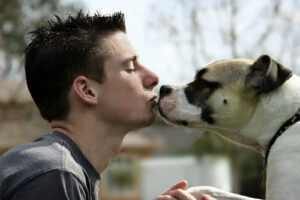Barks Blog
Human vs. Canine Behavior: A Brief Comparison
By Joanne Ometz
“The more I learn about people, the more I like my dog.” – Mark Twain

This quote has become ubiquitous. It is on coffee mugs, bumper stickers, and T-shirts. But why do so many people feel this way about members of our own species? And why do we attribute such high standards of behavior to our canine companions?
Some say dogs are more pure; they love unconditionally and are always there for us. But when it comes to each other, are they really any “better” than us? As a dog trainer and student of canine behavior, I cannot really say dogs behave towards each other in a way that is any more kind and pure than human interactions. They may bully each other, push each other out of the way for human attention, and struggle to win everything else they consider important resources. In these ways at least, they are more similar to humans than we might want to admit. So what is the difference between us?
I believe the difference lies in the prefrontal cortex of the brain. Humans can find ways to hurt each other that are more “creative” and complex. A dog “trained” via the use of aversive equipment may react violently toward what he perceives to be the source of the fear and/or pain, and another dog – or a person, or even an inanimate object – may bear the brunt of that redirected distress. Humans, however, may elect to take out their pain on other humans based precisely on their advanced ability to cause pain to others. This may well be more subtle than a traumatized dog’s behavior, more indirect, less obvious, but it is still redirected pain in the form of physical, verbal, or emotional violence.
What, then, does this have to do with us, as professionals, working with animals? A lot, in my opinion. If you accept that reactive human and canine behavior have these type of similarities, what does that mean for us as a profession? We, as a group, are comprised largely of women and even if you, as an individual, had a happy childhood with safe, stable parents, you most likely have still been affected by sexism and/or living in a world where violence is part of life, all the while navigating redirected traumatization from other human beings. We all carry baggage; it is part of being alive. Nobody gets through life without some level of trauma, even if it is as everyday as being picked last for grade school sports on the playground.
The dogs we work with have the benefit of our compassion, empathy, and expertise and I think we need to extend that same compassion to ourselves and each other too. We need to create a new quote that encompasses the value and dignity of every human being we come in contact with, be it a client or a colleague or even ourselves. Because really, if Twain’s statement is correct, what does that say about us? We are each one of those “people” he refers to, unless we make a concerted effort to be more like the image we hold of our dogs.
About the Author
Joanne Ometz is a dog trainer in Durham, NC. She combines science based training with her fascination for Polyvagal Theory, and a dedication to teaching each pet parent she works with about their dogs’ individual needs as dogs. She can be reached via her website.
